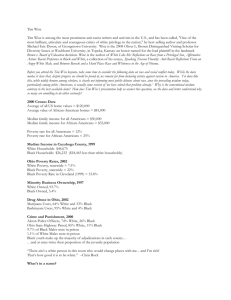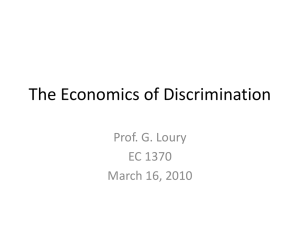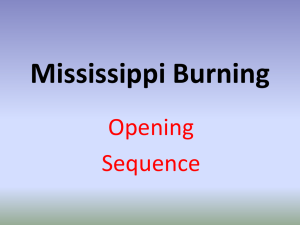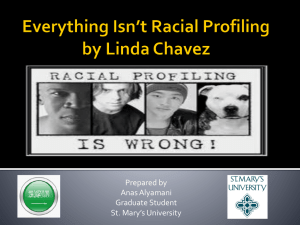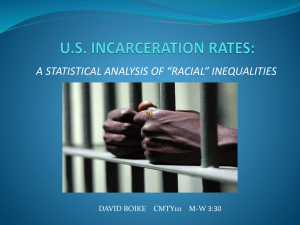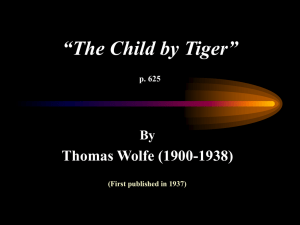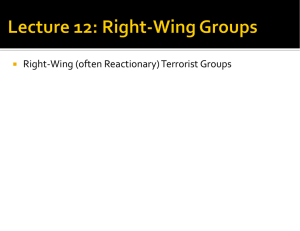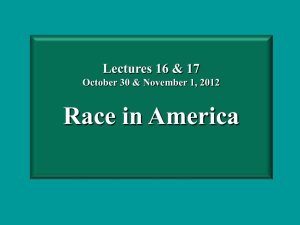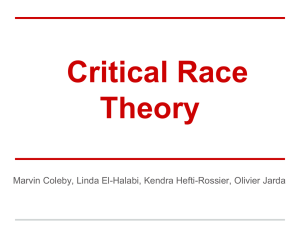Lecture 10 Criminal Injustice
advertisement
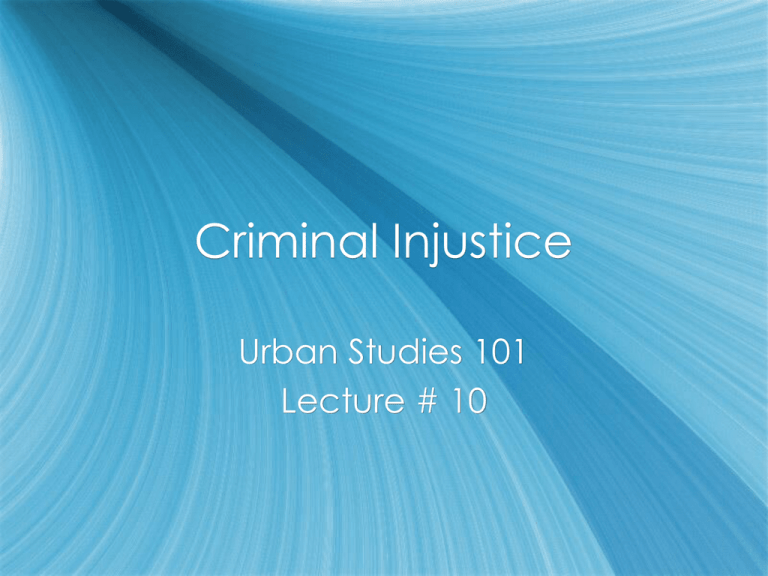
Criminal Injustice Urban Studies 101 Lecture # 10 Criminal Justice Policies In the last twenty years, there has been a dramatic increase in the number of people who are incarcerated in the United States. Mass Incarceration Nationwide, approximately 6.5 million people are in prison, on parole or probation. The prison population in the United States is much higher per capita than in any other industrialized nation. Race and Criminality? Why are blacks and other people of color more likely to be involved with the criminal justice system than are whites? A common answer to this question is that people of color are more prone to criminal activity than are whites. But this answer is wrong !!! Race and Criminality? African Americans make up 12 percent of the nation’s population, but over 40 percent of those arrested on narcotics charges. Race and Criminality? Why are blacks and other people of color more likely to be involved with the criminal justice system than are whites? A common answer to this question is that people of color are more prone to criminal activity than are whites. But this answer is wrong !!! Race and Criminality? Study after study has shown that racial identity is not a reliable factor for predicting criminal activity. Said differently, you cannot tell by someone’s race if he or she is likely to be guilty of committing a crime. Moreover, it is often assumed that people of color are more likely to be arrested on drug charges because people of color use more illegal drugs than whites, and consequently they break more laws. But this is untrue. Race and Criminality? The Department of Health and Human Services has proven that rates of illegal drug use among blacks and whites are almost exactly the same, and that blacks represent only 13 percent of illegal drug users in the United States. However, blacks represent over 60 percent of all narcotics convictions. Race and Mass Incarceration What accounts for this startling difference? The answer is that it is a matter not of race but of racial discrimination. Many defense lawyers, racial justice advocates and people of color believe that there is a pattern of racial bias in the criminal justice system. The five areas of racial bias in the criminal justice system Social scientists have identified three areas of racial bias: Racial profiling; Selective prosecution; Unfair sentencing guidelines Judicial color-blindness Juvenile injustice Racial Profiling Racial profiling is any action undertaken in the name of safety, security or public protection that relies on stereotypes about race, color, ethnicity, ancestry, religion, or place of origin rather than on reasonable suspicion, to single out an individual for greater scrutiny or different treatment. This violates equal projection clause of the 14th Amendment of the Constitution. Not Based on Probable Cause Or Reasonable Suspicion Racial Profiling is the practice of stopping and inspecting people who are passing through public places – such as drivers on public highways or pedestrians in airports or urban areas – where the reason for the stop is based not on probable cause that the detainee has committed a crime, but rather on the detainee's race or ethnicity. One study showed that blacks represent only 13.5 percent of drivers on the New Jersey Turnpike and only 15 percent of those who are speeding. Yet blacks represent 35 percent of all people stopped and 73.5 percent of all those arrested. The Sacramento Valley Mirror , a biweekly newspaper in California, published a memo from a federal law enforcement officer instructing park rangers fighting the war on drugs "to develop probable cause for stop" if the vehicle has Hispanics inside. Selective Prosecution Selective prosecution is the selective enforcement of law enforcement based on race. As with racial profiling, if prosecutors use their discretion unfairly, it violates the guarantee of equal protection for all individuals under the law. Prosecutors have power over many criminal justice decisions, such as the decisions to prosecute, charging decisions, plea bargaining, and bail. Evidence of Selective Prosecution Studies have shown that people of color, blacks and Latinos in particular, are far more likely to be arrested and prosecuted than are whites. One study showed that 90 percent of all people charged with “conspiracy” drug charges in Los Angeles were people of color, despite widespread use of drugs across racial groups including whites. Studies show that prosecutorial decisions to bring charges in federal, rather than state, court work against people of color. From 1988 to 1994, hundreds of blacks and Hispanics — but no whites — were prosecuted by the United States Attorney’s office with jurisdiction over Los Angeles County. From 1992 to 1994, approximately 96.5% of all federal crack prosecutions were of non- whites. It has been proven that prosecutors exercise their discretion cases in ways that cause racially disproportionate outcomes, even in capital cases. Racial Bias in Sentencing Guidelines Discrepancies between penalties work in favor of whites and against people of color. For example, there is a huge discrepancy between penalties for crack use and powder cocaine use, even though these are more or less the same exact substances. Selling or possessing five grams (about $125) of crack cocaine - the form most widely used by the poor blacks - receives a mandatory sentence of at least five years. Someone would have to sell or possess 500 grams (about $50,000) of powdered cocaine – the form most widely used by middleclass whites – to receive the same sentence. If someone is caught with five grams of powdered cocaine, they are unlikely to receive any jail time at all. There is evidence of racial bias in death penalty sentencing as well. Judicial Color-Blindness Those who are discriminated against can petition federal courts for what is called injunctive relief, intervention of the part of the court to stop or reverse a particular situation or condition. But courts often refuse injunctive relief in situations where defendants claim bias in the criminal justice system. Cases of bias are hard to prove. They require defendants to demonstrate that a prosecutor or the police singled him or her out because of his or her race. Courts, including the Supreme Court, have been hostile to this argument when it is made by defendants. They have blocked discovery into the validity of these claims. Supreme Court The cases of Christopher Armstrong and Adolph Lyons. In both cases, the Supreme Court found technical reasons to reject these defendants’ claims of selective prosecution even though a pattern of racial bias was evident. Juvenile injustice Juvenile justice was designed to head off adult criminality. Yet recent juvenile justice policies blur the distinctions between children and adults, and new laws permit youthful offenders to be tried as adults, and to be transferred into adult prison populations. Youth of color suffer most from this policy shift, because they already bear the brunt of racially skewed law enforcement. Evidence of Juvenile Injustice From 1986 to 1991, arrests of white juveniles for drug offenses decreased 34%, while arrests of minority juveniles increased 78%, despite data showing that drug use rates among white, black, and Hispanic youths are about the same. , and that drug use has in fact been lower a Overrepresentation of minority youths in the juvenile justice system increases after arrest. Minority youths tend to be held at intake, detained, proseuted, and held in secure confinement facilities more frequently than their white counterparts. More evidence of Juvenile Injustice Black, Hispanic, and Asian American youths are far more likely to be transferred to adult, state and federal courts, convicted in those courts, and incarcerated in youth or adult prison facilities than white youths. E.G., Native American youth represent 60 percent of youth prosecuted by federal courts, which punish them more severely than local courts. Racial Prejudice in the Criminal Justice System Taken together, these five types of racial bias combine to prejudice the criminal justice system against people of color. They mean that people of color will be more likely to be stopped and arrested, more likely to be prosecuted, and more likely to receive stiff sentences than will whites. They create the perception that most crimes are committed by people of color. They challenge the legitimacy of the system as a whole, undermine its effectiveness, and foster racial division. Voting Bans Only 2 states allow people with felony convictions to vote from prison. All other states have rules for felony convicts varying from taking away the right to vote permanently, depending on the crime (12 states) to allowing felons to vote upon release from all supervision (18 states) to allowing felons to vote upon release from parole to allowing felons to vote upon release from parole prison (5 states). 5.3 million Americans have lost their right to vote because of a former felony offense. Voting Bans & Race 1 of every 8 African-American men is disenfranchised by felon voting bands. What can be done about criminal injustice? What is prison abolition? As we speak, in the Supreme Court… In California prisons, it's been estimated that about a person a week has been dying from lack of medical care, or preventable suicide. Judges have issued a string of orders to try to get the state to improve conditions. Last summer, a three-judge panel decided that these problems just wouldn't go away until California reduced its prison population. So they told the state to cut the prison population down to 137.5% of what the prisons were designed to hold. The state of Ca., however, has appealed the case all the way to the Supreme Court, which heard testimony this past Tuesday.
